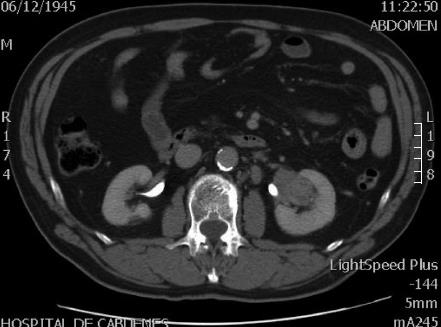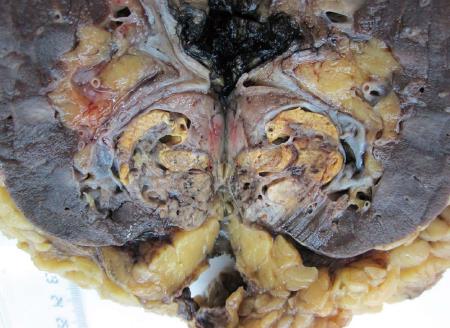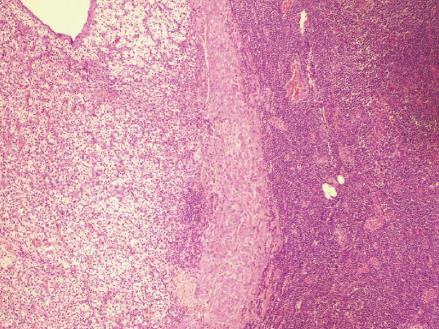Published online Jun 16, 2013. doi: 10.12998/wjcc.v1.i3.121
Revised: April 29, 2013
Accepted: May 16, 2013
Published online: June 16, 2013
Processing time: 169 Days and 17.4 Hours
We report the case of a left laparoscopic nephroureterectomy with the incidental discovery of a non-Hodgkin’s lymphoma in one of the lymph nodes of the renal hilum. A laparoscopic nephroureterectomy was decided on for a 64-year-old man. Renal cell carcinoma in the kidney and one lymph node of the renal hilum with non-Hodgkin’s lymphoma was found. Chemotherapy was not started for the lymphoma discovery. There are no signs of relapse after two years of follow up. Coexistence in the same patient is an extremely rare condition. We review the literature about this issue to clarify this association.
Core tip: This is a case of a nephroureterectomy for a renal mass incidentally discovered by imaging techniques. One of the lymph nodes of the renal hilum was diagnosed as non-Hodgkin’s lymphoma B type, the patient being asymptomatic at that moment. Chemotherapy was not started and extension studies were requested.
- Citation: Fernandez-Pello S, Rodriguez Villamil L, Gonzalez Rodriguez I, Venta V, Cuervo J, Menéndez CL. Lymph node non-Hodgkin's lymphoma incidentally discovered during a nephrectomy for renal cell carcinoma. World J Clin Cases 2013; 1(3): 121-123
- URL: https://www.wjgnet.com/2307-8960/full/v1/i3/121.htm
- DOI: https://dx.doi.org/10.12998/wjcc.v1.i3.121
The association between kidney cancer and lymph node lymphoma is infrequent. The biggest series reported with the two coexisting tumors included no more than twenty patients[1,2]. Nevertheless, many authors have studied this relationship and suggest that it might be a statistical statement rather than sporadic.
We report a case of a nephroureterectomy for a renal mass incidentally discovered by imaging techniques. One of the lymph nodes of the renal hilum was diagnosed as non-Hodgkin’s lymphoma B type. With the patient being asymptomatic, chemotherapy was not started and extension studies were requested.
We review the medical literature about the relationship between kidney cancer and non-Hodgkin’s lymphoma.
We report a 64-year-old man with the incidental ultrasound discovery of a left kidney mass in the context of image studies for elevated blood pressure.
Medical history included ankylosing spondylitis with no other pathologies. Blood analysis showed low platelets with the rest of parameters within normal limits. One of the three urine cytologies showed urothelial atypia.
Abdominal computed tomography (CT) was requested and revealed a solid mass at the lower pole of the left kidney, in touch with the lower calyceal group, and with contrast enhancement, a permeable renal vein and one hilum adenopathy (Figure 1).
Exploration of the ureter with an ureterorenoscopy was performed to exclude ureteral lesions.
After discussion about the case with the contrast enhanced computed tomographic images, we performed a left laparoscopic nephrectomy and ureterectomy. We argued that the laparoscopic nephroureterectomy would not add more morbidity post surgery and it would give us information about the complete upper left urinary system (Figure 2).
The pathology report described a renal clear cell carcinoma, 3.8 cm in diameter and II Fuhrman cell grade. Additionally, lymphoid spreading was reported at one of the lymph nodes of the left renal hilum with pathology stage pT1N0. These findings and the immunochemistry studies (which were positive for CD20, bcl-2 and bcl-6 and negative for CD10) were in concordance with follicular non-Hodgkin’s lymphoma B type and cell grade 2, with extension out of the node capsule and peripheral fat (Figure 3).
The post operative course was uneventful and the patient was discharged on the fifth day.
The patient was followed up by urology and hematology. Extension studies were requested and a neck-thorax-abdominal CT showed no special radiological findings. Bone marrow biopsy was negative for lymph proliferative disease. Chemotherapy was not started and after two years of follow up, the patient is asymptomatic with no imaging signs of relapse in the control studies that were requested.
The American Cancer Society has reported that one of five Americans will develop cancer in their lifetime. For those patients who develop a tumor, the chance of developing a second tumor during their lifetime is one in three[1].
Renal cell carcinoma (RCC) and non-Hodgkin’s lymphoma are relatively common neoplasms that have dramatically different natural histories and management strategies. These neoplasms are considered curable in the early stages but the ability to treat the advanced disease is much more limited in renal cell carcinoma[3].
Second malignancies reported to be associated with renal cell carcinoma include bladder[4], prostate, rectum[5], lung[6], non-Hodgkin’s lymphoma and melanoma. In general, 27.4% of the cases were related previously, 44.5% were synchronous and 39.2% were subsequent. Rabbani et al[7] reported the specific association between non-Hodgkin’s lymphoma and RCC from the whole sample of patients with RCC (763 patients) with a second primary malignancy (209 patients). They described 19 cases of non-Hodgkin’s lymphoma, 8 as an antecedent, 8 synchronous and 3 metachronous[7].
Many authors have reported the association between non-Hodgkin’s lymphoma and kidney cancer but there are contradictory results[8]. However, in one of the biggest series with patients affected by the two kinds of tumors (1425 patients), the standardized incidence of ratios (SIR) were used to estimate the risk of later primary cancer in patients diagnosed with renal cancer, calculated as the ratio of observed numbers (ONo) and expected numbers (ENo) of cases. The SIR for a second primary cancer in patients with RCC was significantly higher for bladder cancer, melanoma and non-Hodgkin’s lymphoma. Additionally, non-Hodgkin’s lymphoma was reported to occur with a much stronger rate after renal transplantation[9].
In 1996, Tihan et al[2] studied the coexistence of RCC and lymphoma, with 1252 renal cancer patients and 1660 non-Hodgkin’s lymphoma patients reported. Two neoplasms coexisted in 15 patients, 11 females and 4 males. The average age was 62 years. The clinical presentation of patients with coexisting RCC and non-Hodgkin’s lymphoma showed three patterns. In the most common pattern, patients developed lymphoma and staging work up revealed a low grade renal cancer. The second pattern was a renal mass and incidental diagnosis of low grade lymphoma located at the retroperitoneum or spleen. In the third pattern, there were 9 years between the occurrence of renal neoplasm and lymphoma. Most of the renal masses were managed by nephrectomy and the lymphoma with chemotherapy. Complete remission was reported in 50% of cases. Consequently, there was a statistical association and the possible etiology could be immune deficiencies or genetic/familiar predisposition[2].
In conclusion, we report the case of a patient that, after an intervention for a kidney tumor, a follicular non-Hodgkin’s lymphoma was discovered in one of the lymph nodes of the renal hilum. The coexistence of RCC and non-Hodgkin’s lymphoma is infrequent. However, many reports have investigated if this association is sporadic or statistical. In spite of the existence of papers in both directions, the most important studies with a significant number of patients suggest that the relationship between these two neoplasms is stronger than other kinds of tumors.
P- Reviewer Yokoyama J S- Editor Wen LL L- Editor Roemmele A E- Editor Ma S
| 1. | Trichopoulos D, Li FP, Hunter DJ. What causes cancer. Sci Am. 1996;275:80-87. [RCA] [PubMed] [DOI] [Full Text] [Cited by in Crossref: 64] [Cited by in RCA: 52] [Article Influence: 1.8] [Reference Citation Analysis (0)] |
| 2. | Tihan T, Filippa DA. Coexistence of renal cell carcinoma and malignant lymphoma. A causal relationship or coincidental occurrence. Cancer. 1996;77:2325-2331. [PubMed] |
| 3. | Kantor AF, McLaughlin JK. Second cancer following cancer of the urinary system in Connecticut, 1935-82. Natl Cancer Inst Monogr. 1985;68:149-159. [PubMed] |
| 4. | Greenberg RS, Rustin ED, Clark WS. Risk of genitourinary malignancies after cancer of the prostate. Cancer. 1988;61:396-401. [PubMed] |
| 5. | Kantor AF, McLaughlin JK, Curtis RE, Flannery JT, Fraumeni JF. Risk of second malignancy after cancers of the renal parenchyma, renal pelvis, and ureter. Cancer. 1986;58:1158-1161. [PubMed] |
| 6. | Begg CB, Zhang ZF, Sun M, Herr HW, Schantz SP. Methodology for evaluating the incidence of second primary cancers with application to smoking-related cancers from the Surveillance, Epidemiology, and End Results (SEER) program. Am J Epidemiol. 1995;142:653-665. [PubMed] |
| 7. | Rabbani F, Reuter VE, Katz J, Russo P. Second primary malignancies associated with renal cell carcinoma: influence of histologic type. Urology. 2000;56:399-403. [RCA] [PubMed] [DOI] [Full Text] [Cited by in Crossref: 52] [Cited by in RCA: 54] [Article Influence: 2.2] [Reference Citation Analysis (0)] |
| 8. | Rabbani F, Russo P. Lack of association between renal cell carcinoma and non-Hodgkin’s lymphoma. Urology. 1999;54:28-33. [RCA] [PubMed] [DOI] [Full Text] [Cited by in Crossref: 18] [Cited by in RCA: 18] [Article Influence: 0.7] [Reference Citation Analysis (0)] |
| 9. | Beisland C, Talleraas O, Bakke A, Norstein J. Multiple primary malignancies in patients with renal cell carcinoma: a national population-based cohort study. BJU Int. 2006;97:698-702. [RCA] [PubMed] [DOI] [Full Text] [Cited by in Crossref: 80] [Cited by in RCA: 99] [Article Influence: 5.2] [Reference Citation Analysis (0)] |















